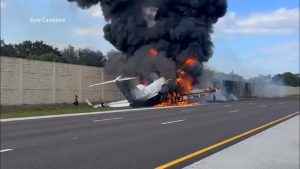Since making landfall at Cayo Costa, southwest Florida, Ian has downgraded from a category four hurricane to a tropical storm with a speed of 70 miles per hour. It will reach South Carolina next, on Friday, but its intensity will fall by then and it will become a category 1 storm, according to the National Hurricane Center (NHC).
Since hitting Florida on Wednesday, Ian has caused significant destruction and damage. The gushing winds combined with torrential rains brought Florida to a standstill with road blockages, severe flooding, power outages in thousands of homes, and at least 15 confirmed deaths.
Also read: Hurricane Ian: Sharks show up on streets, water gushes through homes
As the state lay in disarray, recuperating from the hurricane’s 150 mph wind speeds, president Joe Biden said on Thursday, “The numbers are still unclear, but we’re hearing early reports of what may be substantial loss of life.”
Lee County Sheriff, Carmine Marcino, took a tour of the entire county in a helicopter since the wind speed fell. He told CNN,” I have really no words that I can say to tell you what I’ve seen”. While surveying the Fort Meyers Beach Area, he saw buildings and houses completely washed, vehicles submerged in water, and boats in the Bay area all upturned by the winds.
The videos and pictures of the storm’s impact shared on social media also showed the extent of damage it caused.
Also read: Hurricane Ian makes landfall in Florida as Category 4 storm
Even though Ian has now downgraded to a tropical storm, and its speed is going to fall even more as it reaches South Carolina, there is no shortage of caution in the Old South.
The entire coast of South Carolina has been placed under Hurricane warning, by the National Hurricane Center. The route of the storm from Jupiter in Florida to the east coast of Duck in North Carolina has been issued a Tropical storm warning.






